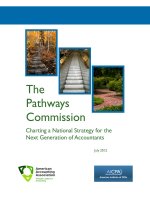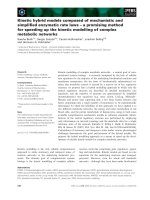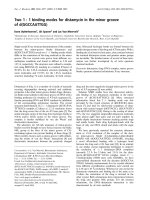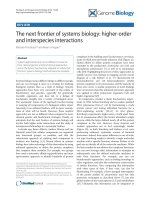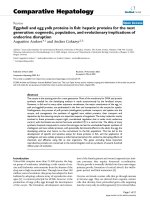Evidence informed deliberative processes for HTA around the globe exploring the next frontiers of HTA and best practices; comment on “use of evidence informed deliberative processes by health technology assessment
Bạn đang xem bản rút gọn của tài liệu. Xem và tải ngay bản đầy đủ của tài liệu tại đây (312.21 KB, 5 trang )
Int J Health Policy Manag 2021, 10(4), 232–236
doi 10.34172/ijhpm.2020.145
Commentary
Evidence-Informed Deliberative Processes for HTA Around
the Globe: Exploring the Next Frontiers of HTA and Best
Practices
Comment on “Use of Evidence-informed Deliberative Processes by Health Technology
Assessment Agencies Around the Globe”
ID
Unni Gopinathan1* , Trygve Ottersen1, Pascale-Renée Cyr2, Kalipso Chalkidou3,4
ID
Abstract
This comment reflects on an article by Oortwijn, Jansen, and Baltussen about the use and features of ‘evidenceinformed deliberative processes’ (EDPs) among health technology assessment (HTA) agencies around the world
and the need for more guidance. First, we highlight procedural aspects that are relevant across key steps of EDP,
focusing on conflict of interest, the different roles of stakeholders throughout a HTA and public justification of
decisions. Second, we discuss new knowledge and models needed to maximize the value of deliberative processes
at the expanding frontiers of HTA, paying special attention to when HTA is applied in primary care, employed for
public health interventions, and is produced through international collaboration.
Keywords: Health Technology Assessment, Health Policy, Deliberative Processes, Decision-Making, Priority Setting
Copyright: © 2021 The Author(s); Published by Kerman University of Medical Sciences. This is an open-access
article distributed under the terms of the Creative Commons Attribution License ( />licenses/by/4.0), which permits unrestricted use, distribution, and reproduction in any medium, provided the
original work is properly cited.
Citation: Gopinathan U, Ottersen T, Cyr PR, Chalkidou K. Evidence-informed deliberative processes for HTA
around the globe: exploring the next frontiers of HTA and best practices: Comment on “Use of evidence-informed
deliberative processes by health technology assessment agencies around the globe.” Int J Health Policy Manag.
2021;10(4):232–236. doi:10.34172/ijhpm.2020.145
Introduction
Healthcare needs exceed available resources in every country.1
Setting efficient and equitable health priorities require both
appropriate substantive criteria and fair process.2 To achieve
the latter, scholars have argued the need for deliberative
processes that satisfy key qualities, including transparency,
broad involvement of stakeholders, consideration of outcomes
valued by stakeholders, and mechanisms for appeal, revision
and enforcement.3,4 National institutions that support evidenceinformed priority setting, such as the United Kingdom’s
National Institute of Health and Care Excellence (NICE),
have to some extent institutionalized deliberative processes.5
Deliberative processes, guided by the Accountability for
Reasonableness framework, have also been tested as part of
priority setting at district levels in low- and middle-income
countries.6
In their recent article, Oortwijn, Jansen and Baltussen
(henceforth Oortwijn et al) present findings from a survey
that asked members of the International Network for Agencies
for Health Technology Assessment (INAHTA) about their
use of deliberative processes.7 Oortwijn et al apply the
term “evidence-informed deliberative processes” (EDPs) to
describe how “HTA [health technology assessment] agencies
Full list of authors’ affiliations is available at the end of the article.
Article History:
Received: 21 May 2020
Accepted: 21 July 2020
ePublished: 5 August 2020
*Correspondence to:
Unni Gopinathan
Email:
should ideally organize their processes to achieve legitimate
decision-making.”7 A general critique that can be leveled
against the use of “EDP” to describe these processes is that it
promotes the perception that it represents a “new” approach
to explicitly addressing the issue of legitimacy, when it in fact
involves qualities that resemble deliberative processes that
have been set up in the context of healthcare priority setting
at least for several decades.4,5
Oortwijn et al have previously developed a guide describing
key steps of EDP: setting up an appraisal committee, defining
decision criteria that reflect shared values and establishing a
process for identifying and selecting health technologies for
HTA, assessing and appraising a specific HTA, and finally
communication and the opportunity for appeal.8 These steps
form the basis of their survey of INAHTA members. Here, they
investigate the extent to which INAHTA member agencies
use the different steps of an EDP and the extent to which these
agencies are in need of guidance for implementing these steps.
We provide two sets of reflections. First, we highlight key
procedural aspects, tied to key steps addressed by the survey
but that are relevant across these steps, where more guidance
is needed. Second, we discuss new knowledge and models
needed to maximize the value at the expanding frontiers
Gopinathan et al
of HTA, focusing on when HTA is applied in primary care,
employed for public health interventions, and produced
through international collaboration.
Key Procedural Aspects in the Deliberative Process Where
Guidance Is Needed
Through their survey, Oortwijn et al drew attention to a
wide range of procedural aspects that define a deliberative
process for HTA. Oortwijn et al tie these aspects to specific
steps outlined in their model for EDP. In the following, we
highlight three aspects relevant across the key steps of EDP,
where efforts to define ‘best practices’ can generate value.
First, with respect to the first step of establishing a
committee and stakeholder panel for appraising the health
technology in question, between 38%-46% of the respondents
requested guidance for addressing composition, terms, and
selection, roles and responsibilities, and approaches. Clarity
about these features is imperative to securing scientific
independence and protecting a committee from undue
influence of financial, institutional and intellectual interests.9
This is also important for clarifying the relative differences in
power and potential influence of the stakeholders involved, so
that HTA organizations can take this into account to uphold
a fair process.
While Oortwijn and colleagues’ questionnaire raise the
importance of stating conflict of interest, it did not explicitly
ask HTA organizations about the policy they have in place
for systematically identifying financial and non-financial
interests held by stakeholders. Recent experiences among
HTA organizations suggest such policies and good practice
are crucial for maintaining integrity of the HTA process.
For example, in France, reported conflicts of interest among
members responsible for guidance development in the
French national health agency (Haute Autorité de Santé) led
to review and withdrawal of several guidelines.10 Moreover,
direct industry influence commonly receive most attention;
yet a recent study identified that funding by manufacturers
of technologies under appraisal is highly prevalent among
patient organisations contributing to HTA in England.11
While deliberation is considered integral to sound HTA,
deliberation without clear policies for addressing conflict of
interest risks doing more harm than good, for example via
capture of the process by stakeholders with vested interests.
A more detailed assessment of how the interests of different
stakeholders are identified, made transparent, and managed
when committees and stakeholder panels are formed would
be useful for identifying best practice.
Second, the survey findings indicated a demand for more
guidance about roles and responsibilities when different
stakeholders are involved, especially with assessment and
appraisal. The need for guidance on this matter point to several
things. First, while stakeholder involvement is a key factor for
promoting a fair process throughout scoping, assessment and
appraisal, it is not necessarily so that the same type or number
of stakeholders should cover these steps. For example, it
is relevant that organizations representing the disease in
question is involved to give input on what the key outcomes
are, while a patient organizations representing diseases more
broadly might be relevant to involve at a later state reflecting
the need to evaluate priorities across diseases. Second,
reflecting pivotal questions raised in a background paper for
the 2020 HTAi Global Policy Forum, is whether deliberative
processes afford opportunities to promote a wide range of
values, whether participation allow for promoting competing
interpretations of the need for the health intervention in
question, and whether perspectives are integrated in such way
that promotes learning among all the involved stakeholders.12
Third, over 90% indicated that HTA agencies make public
decisions or make public to some extent the decisions and
underlying reasons. Given the crucial role that publicity about
the grounds for decisions play for a fair process, more careful
scrutiny of how publicity is practiced is needed. Of particular
importance is whether the agencies transparently report their
data, models, social value judgements, and if the information
is made available in a language accessible to the public.6,13,14
Moreover, to promote legitimacy, transparency is needed not
only after decisions have been made but also throughout the
HTA process.
There are limitations to using the survey findings to distill
generalizable lessons. When surveying and comparing
country experiences to assess the value of HTAs for health
systems decisions, awareness of (1) the different nature of
HTA organizations and (2) the extent to which HTAs and
deliberative processes is put to use for the wide range of
health systems decisions is important. The first speaks to
the fact that HTA organizations across different countries
have very different functions. While in the United Kingdom
the decision-making processes and committees for
reimbursements decisions informed by HTA rests within
NICE, in other countries HTA organizations serve an
advisory role responsible for evidence generation without
decision-making authority nor influence over the design of
the deliberative process.15 Moreover, given the wide range of
experiences across differing contexts, it can be a better aim to
identify a ‘package’ of best practices since sound practice in
one setting might not be easily transferable to another.
The second point speaks to the fact that a range of health
systems decisions function without the use of HTA or similar
evidence-informed assessments nor a deliberative process.
This includes, for example, health financing choices related to
revenue generation and pooling, where the need for explicit
and deliberative processes have received less scrutiny than
for purchasing. Moreover, implicit priority setting frequently
occur when resources are allocated without being subject
to deliberations where evidence of benefits and harms,
assumptions, trade-offs and social values are made explicit.
The latter is for example true for resources allocated to
countries by the Global Fund, which is yet to systematically
make use of HTAs when determining which interventions to
support.16,17
We agree with the authors that a response rate covering a
little more than half (54%) of INAHTA members might be
hiding two types of gaps. First, the lack of response risks hiding
weaknesses among other agencies, which would suggest that
International Journal of Health Policy and Management, 2021, 10(4), 232–236
233
Gopinathan et al
a greater number of agencies than those who responded are
in need of guidance about various aspects of designing a
sound deliberative process. Second, experiences beyond those
surveyed should be investigated in order to obtain a global
view. From a total of 50 INAHTA member agencies in 2018,
Oortwijn et al received a complete response from 25 agencies,
and the majority of these (15) were European HTA agencies.
In spite of the recent growth of HTA agencies in Asia and
Latin America, only seven agencies from these two regions
left a response. In comparison, an other member organization
in Asia, HTAsialink, have 24 agencies from 15 countries:
Australia, Bhutan, China, Indonesia, Japan, Kazakhstan,
Malaysia, Mongolia, New Zealand, Philippines, Korea,
Singapore, Taiwan, Thailand, and Vietnam. It is crucial that
the perspectives of these and other agencies on good practice
with respect to deliberative processes are considered.
Opportunities Going Forward: Exploring the Next
Frontiers of HTA
Universal health coverage is a widely promoted policy goal in
the sustainable development agenda. In response, countries at
different income levels are increasingly setting up institutions
to facilitate explicit priority setting processes informed by
HTAs when allocating scarce health resources.19-22 To facilitate
sharing of country experiences and to identify factors that
can promote the use of HTA, detailed national and regional
assessments of HTA institutionalization haven taken place.23,24
Moreover, capacity among policy-makers to make use of HTA
and deliberate with other stakeholders is sought strengthened
in different settings.23,25 Oortwijn et al promote a view that key
features of a deliberative process should be present at every
step of prioritizing health interventions and at every level
where health interventions are prioritized. This position is
shared by many,12,18 and promising experiences suggest that
the frontiers of HTA is being expanded.
First, the most frequent use of HTA is to inform public
reimbursement decisions for health technologies used in
specialist healthcare. However, countries are increasingly
considering how priority-setting can be done across
different levels of care, and how HTA can be applied to
services delivered at the municipal level, especially primary
care services. For example, in 2018, a national committee
mandated by the Norwegian government proposed the
use of criteria and processes similar to specialist healthcare
for priority setting of health services, including preventive
services, at the municipal level.26
Moreover, a few countries are now experimenting with
approaches at the level of local government that facilitate
involvement of end users at the point of topic selection. For
example, in Norway, a pilot has been implemented among
11 municipalities to motivate the use of evidence to inform
decisions about health and social services, and public
health.27 A unique feature of this pilot was to generate a
demand for research evidence among decision-makers in the
municipalities. Frontline providers and local policy-makers
were motivated to suggest interventions, ideally ones they are
considering for implementation, for assessment of evidence
234
by the Norwegian Institute of Public Health. Similarly, the
UK’s National Institute of Health Research is developing a
programme — the Public Health Intervention Responsive
Studies Teams — to support evidence-informed delivery
and implementation of public health interventions.28 A key
feature of these initiatives is the emphasis on joint ownership,
whereupon researchers and local policy-makers jointly
prioritize topics and consider the value of evaluations.
Second, the use of HTAs for public health interventions
is receiving growing attention,29,30 and presents its own set
of challenges and opportunities with respect to deliberative
processes for HTA. For example, stakeholder involvement can
be particularly demanding for public health interventions.
These interventions typically demand involvement of
different sectors, affect interests of different sectors, and
require explicit consideration of outcomes beyond health.31
Moreover, in many settings, the responsibility for delivering
public health interventions has been decentralized to local
government (eg, municipal level), where the use of HTAs and
evidence-informed guidance during deliberative processes is
immature and evolving.32 Overall, for public health decisions,
the scope of actors involved with EDPs is likely to be even
wider than for clinical care.
Finally, increasing international collaboration, particularly
shared functions and joint production to promote efficient
use of HTAs, is expected to push the frontiers of HTA, while
posing new challenges and opportunities for deliberation.
For example, deliberation at the stage of horizon scanning
has been less explored than deliberation during the process
of conducting an HTA, but several major international HTA
collaborations have piloted joint processes and deliberation
as part of horizon scanning. In the European setting, the
Beneluxa collaboration, involving Belgium, the Netherlands,
Luxembourg, Austria and Ireland, aims to promote
joint horizon scanning for emerging drugs and health
technologies.33 Moreover, the collaboration EUnetHTA is
piloting joint topic identification, selection and prioritization
as part of testing joint horizon scanning functions.34 The
role of horizon scanning was also the theme of the 2019
HTAi policy forum in Asia, which underscored the need
for a transparent horizon scanning process that fosters early
dialogue among HTA agencies, providers and industry about
technologies in a clinical pathway, and the need for a shared
Asian horizon scanning network.35
Conclusion
Ooortwijn et al have provided an early baseline assessment
of the experience HTA organizations worldwide have with
different steps of the deliberative process for HTAs. Using
their work as point of departure, we have highlighted critical
procedural aspects — managing conflict of interest, clarifying
the different roles of stakeholders at different steps, and
public justification of decisions — where efforts to define
best practices can generate value. Defining such practices
should consider the different roles HTA agencies take on
during decision-making processes in health systems, and be
informed by in-depth comparative work of experiences with
International Journal of Health Policy and Management, 2021, 10(4), 232–236
Gopinathan et al
the next frontiers of HTA, including when HTA is applied in
primary care, employed for public health interventions, and is
produced through international collaboration.
14.
Acknowledgements
We thank the two peer-reviewers for providing comments
that helped improve the quality of the manuscript.
15.
Ethical issues
Not applicable.
16.
Competing interests
UG and TO work for the Norwegian Institute of Public Health, which is an
INAHTA member.
17.
Authors’ contributions
All authors contributed to drafting the manuscript and critically revising it for
intellectual content. All authors read and approved the final manuscript.
18.
Authors’ affiliations
1
Division for Health Services, Norwegian Institute of Public Health, Oslo, Norway.
Department of Community Medicine and Global Health, Institute of Health and
Society, University of Oslo, Oslo, Norway. 3Global Health Development Group,
Imperial College London School of Public Health, London, UK. 4Center for
Global Development Europe, London, UK.
2
19.
References
1.
2.
3.
4.
5.
6.
7.
8.
9.
10.
11.
12.
13.
World Health Organization (WHO). Making Fair Choices on the Path
to Universal Health Coverage: Final report of the WHO Consultative
Group on Equity and Universal Health Coverage. WHO; 2014.
Norheim OF. Ethical priority setting for universal health coverage:
challenges in deciding upon fair distribution of health services. BMC
Med. 2016;14:75. doi:10.1186/s12916-016-0624-4
Daniels N, Sabin JE. Setting Limits Fairly: Learning to Share
Resources for Health. Oxford: Oxford University Press; 2008.
Daniels N. Accountability for reasonableness. BMJ. 2000;321(7272):
1300-1301. doi:10.1136/bmj.321.7272.1300
Culyer AJ. NICE’s use of cost effectiveness as an exemplar of a
deliberative process. Health Econ Policy Law. 2006;1(Pt 3):299-318.
doi:10.1017/s1744133106004026
Byskov J, Marchal B, Maluka S, et al. The accountability for
reasonableness approach to guide priority setting in health systems
within limited resources--findings from action research at district level
in Kenya, Tanzania, and Zambia. Health Res Policy Syst. 2014;12:49.
doi:10.1186/1478-4505-12-49
Oortwijn W, Jansen M, Baltussen R. Use of evidence-informed
deliberative processes by health technology assessment agencies
around the globe. Int J Health Policy Manag. 2020;9(1):27-33.
doi:10.15171/ijhpm.2019.72
Oortwijn W, Jansen M, Baltussen R. Evidence-Informed Deliberative
Processes: A Practical Guide for HTA Agencies to Enhance Legitimate
Decision-Making. Version 1.0. Nijmegen: Radboud University Medical
Centre, Radboud Institute for Health Sciences; 2019.
Making sense of non-financial competing interests. PLoS Med.
2008;5(9):e199.
doi:10.1371/journal.pmed.0050199
Frybourg S, Remuzat C, Kornfeld Å, Toumi M. Conflict of interest in
Health Technology Assessment decisions: case law in France and
impact on reimbursement decisions. J Mark Access Health Policy.
2015;3(1):25682. doi:10.3402/jmahp.v3.25682
Mandeville KL, Barker R, Packham A, Sowerby C, Yarrow K,
Patrick H. Financial interests of patient organisations contributing to
technology assessment at England’s National Institute for Health and
Care Excellence: policy review. BMJ. 2019;364:k5300. doi:10.1136/
bmj.k5300
Bond K. Deliberative Processes in Health Technology Assessment:
Prospects, Problems, and Policy Proposals. Global Policy Forum;
2020.
Panteli D, Nolting A, Eckhardt H, Kulig M, Busse R. Published
20.
21.
22.
23.
24.
25.
26.
27.
28.
29.
and unpublished evidence in coverage decision-making for
pharmaceuticals in Europe: existing approaches and way forward.
Health Res Policy Syst. 2016;14:6. doi:10.1186/s12961-016-0080-9
Bullement A, Taylor M, McMordie ST, Waters E, Hatswell AJ. NICE,
in confidence: an assessment of redaction to obscure confidential
information in single technology appraisals by the National Institute for
Health and Care Excellence. Pharmacoeconomics. 2019;37(11):13831390. doi:10.1007/s40273-019-00818-0
Allen N, Pichler F, Wang T, Patel S, Salek S. Development of
archetypes for non-ranking classification and comparison of European
National Health Technology Assessment systems. Health Policy.
2013;113(3):305-312.
doi:10.1016/j.healthpol.2013.09.007
Kanpirom K, Luz ACG, Chalkidou K, Teerawattananon Y. How should
global fund use value-for-money information to sustain its investments
in graduating countries? Int J Health Policy Manag. 2017;6(9):529533. doi:10.15171/ijhpm.2017.25
Teerawattananon Y, McQueston K, Glassman A, Yothasamut J, Myint
CY. Health technology assessments as a mechanism for increased
value for money: recommendations to the Global Fund. Global Health.
2013;9:35. doi:10.1186/1744-8603-9-35
Culyer AJ. Use of evidence-informed deliberative processes - learning
by doing comment on “ use of evidence-informed deliberative
processes by health technology assessment agencies around the
globe.” Int J Health Policy Manag. 2020;9(6):263-265. doi:10.15171/
ijhpm.2019.116
Augustovski F, Alcaraz A, Caporale J, García Martí S, Pichon Riviere
A. Institutionalizing health technology assessment for priority setting
and health policy in Latin America: from regional endeavors to
national experiences. Expert Rev Pharmacoecon Outcomes Res.
2015;15(1):9-12. doi:10.1586/14737167.2014.963560
Hollingworth S, Gyansa-Lutterodt M, Dsane-Selby L, et al.
Implementing health technology assessment in Ghana to support
universal health coverage: building relationships that focus on people,
policy, and process. Int J Technol Assess Health Care. 2020;36(1):811. doi:10.1017/s0266462319000795
Mohara A, Youngkong S, Velasco RP, et al. Using health technology
assessment for informing coverage decisions in Thailand. J Comp Eff
Res. 2012;1(2):137-146. doi:10.2217/cer.12.10
Sharma M, Teerawattananon Y, Luz A, Li R, Rattanavipapong
W, Dabak S. Institutionalizing evidence-informed priority setting
for universal health coverage: lessons from Indonesia. Inquiry.
2020;57:46958020924920.
doi:10.1177/0046958020924920
Tantivess S, Chalkidou K, Tritasavit N, Teerawattananon Y. Health
Technology Assessment capacity development in low- and middleincome countries: experiences from the international units of HITAP and
NICE. F1000Res. 2017;6:2119. doi:10.12688/f1000research.13180.1
World Health Organization, Regional Office for the Western Pacific.
Factors Conducive to the Development of Health Technology
Assessment in Asia: Impacts and Policy Options. Manila: WHO
Regional Office for the Western Pacific; 2015.
Li R, Ruiz F, Culyer AJ, Chalkidou K, Hofman KJ. Evidence-informed
capacity building for setting health priorities in low- and middle-income
countries: a framework and recommendations for further research.
F1000Res. 2017;6:231. doi:10.12688/f1000research.10966.1
NOU 2018: 16. Det viktigste først — Prinsipper for prioritering i den
kommunale helse- og omsorgstjenesten og for offentlig finansierte
tannhelsetjenester. Helse- og omsorgsdepartementet; 2018.
Available from: Published December 13, 2018.
Bergen
Kommune.
Pilot
for
kunnskapsoppsummeringer
med kommunene. Bergen Kommune website. https://www.
bergen.kommune.no/hvaskjer/tema/kunnskapskommunen/
kunnskapsoppsummeringer.
Published
2019.
NIHR. Public Health Intervention Responsive Studies Teams
(PHIRST) - call for Local Authority Initiatives specification document.
Published 2020.
Polus S, Mathes T, Klingler C, et al. Health technology assessment
of public health interventions published 2012 to 2016: an analysis
of characteristics and comparison of methods. Int J Technol Assess
International Journal of Health Policy and Management, 2021, 10(4), 232–236
235
Gopinathan et al
30.
31.
32.
33.
236
Health Care. 2019;35(4):280-290. doi:10.1017/s0266462319000515
Jain V, Baker P, Chalkidou K. Harnessing the power of health taxes.
BMJ. 2020;369:m1436. doi:10.1136/bmj.m1436
Kriegner S, Ottersen T, Røttingen JA, Gopinathan U. Promoting
intersectoral collaboration through the evaluations of public health
interventions: insights from key informants in 6 European countries.
Int J Health Policy Manag. 2020. doi:10.34172/ijhpm.2020.19
Atkins L, Kelly MP, Littleford C, Leng G, Michie S. From the National
Health Service to local government: perceptions of public health
transition in England. Public Health. 2019;174:11-17. doi:10.1016/j.
puhe.2019.05.016
Lepage-Nefkens I, Douw K, Mantjes G, de Graaf G, Leroy R, Cleemput
I. Horizon Scanning for Pharmaceuticals: Proposal for the BeNeLuxA
34.
35.
Collaboration. />Horizon%20scanning_ScientificReport_full.pdf. Accessed May 15,
2020.
Erdös J, Ettinger S, Mayer-Ferbas J, de Villiers C, Wild C. European
Collaboration in Health Technology Assessment (HTA): goals,
methods and outcomes with specific focus on medical devices. Wien
Med Wochenschr. 2019;169(11-12):284-292. doi:10.1007/s10354019-0684-0
HTAi Asia Policy Forum 2019. Background Paper: Sustainability of
Healthcare Systems in Asia: Exploring the Roles of Horizon Scanning
and Reassessment in the HTA Landscape. />Published 2019.
International Journal of Health Policy and Management, 2021, 10(4), 232–236

